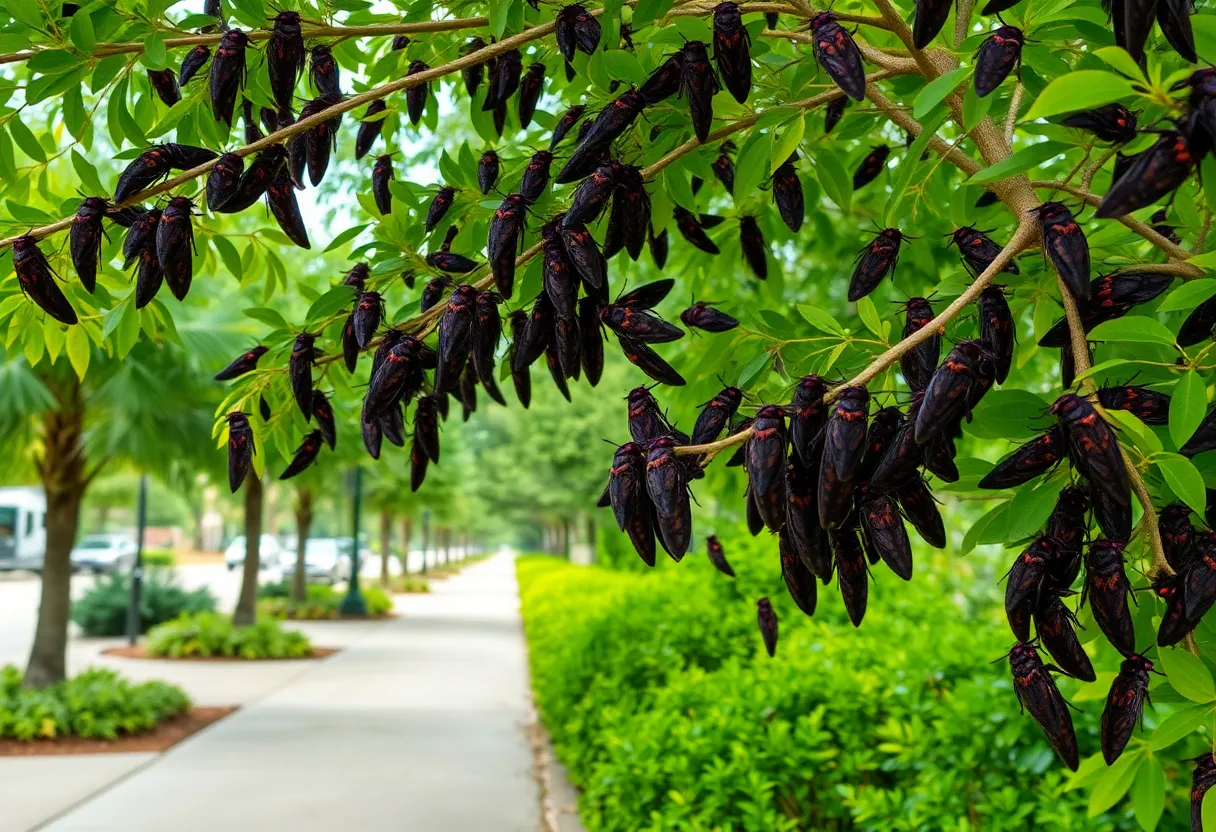News Summary
The Bourbon Brood cicadas, or Brood XIV, have emerged in large numbers after 17 years underground, primarily in central and eastern Kentucky and portions of southern Indiana. Triggered by rising temperatures, these cicadas create a distinctive buzzing chorus as they molt and mate. While their presence is striking, they are mostly harmless, with a brief adult stage that lasts a few weeks. Local authorities advise residents to delay tree plantings to prevent damage from egg-laying females, as communities prepare for this spectacular natural event.
Lexington, Kentucky – The Bourbon Brood cicadas, scientifically referred to as Brood XIV, have emerged in significant numbers across Kentucky and southern Indiana after spending nearly 17 years underground as nymphs. This event marks the latest cicada emergence in the region, following their last appearance in 2008.
The notable emergence of these cicadas is triggered by rising ground temperatures, specifically when they reach above 64 degrees Fahrenheit. Once this temperature threshold is met, the cicadas begin to surface, molt, and participate in their mating and reproduction cycle. During this phase, the iconic buzzing chorus, created primarily by male cicadas, envelops trees, structures, and sidewalks across Kentucky.
Reports indicate that the cicadas are particularly concentrated in central and eastern Kentucky, but sightings have also been documented in southern Indiana, parts of Tennessee, Ohio, and even as far away as Georgia. The periodical cicadas, including various species known for their distinctive dark bodies and red eyes, are typically harmless despite their overwhelming presence. In fact, their adult stage is brief, lasting only a few weeks during which males attract females through their loud calls.
Once mating occurs, female cicadas lay eggs in tree branches. Following incubation, the young cicadas will hatch and burrow into the ground, continuing the cycle that will not repeat for another 17 years. This synchronized emergence strategy is believed to minimize competition among the cicadas, with a total of 12 known 17-year broods and three 13-year broods documented in North America.
The cicadas’ sounds can reach levels comparable to that of a jet engine, creating a remarkable auditory experience throughout their emerging areas. However, some residents have reported cicadas invading homes and vehicles, prompting local officials to recommend delaying any new tree plantings until late June to avoid potential damage caused by egg-laying females.
As the emergence unfolds, local communities are responding with both concern and fascination. Entomologists like those from the University of Kentucky highlight the cicadas’ distinctive “romantic” sounds, portraying them as a natural spectacle in the environment. The enthusiasm surrounding the current emergence, sometimes referred to as the “Bourbon Brood,” has attracted national attention as communities prepare to celebrate this compelling natural occurrence.
The emergence of periodical cicadas is a fascinating phenomenon in which these insects emerge in substantial numbers without resembling typical insect invasions. Rather, this biological event serves as a reminder of nature’s cycles, where these creatures, once reclusive underground, burst forth in a grand display of life and reproduction before returning to the earth once again.
As the Bourbon Brood showcases their remarkable presence, residents are encouraged to observe the spectacle while understanding the ecological role these cicadas play in their environment. Their emergence is a fleeting yet profound reminder of the intricate and extraordinary relationships within the natural world, making this event worthy of attention and appreciation.
Deeper Dive: News & Info About This Topic
HERE Resources
Brood XIV Cicadas Emerge in Louisville, Kentucky
Additional Resources
- Kentucky.com
- Wikipedia: Cicada
- WHAS11
- Google Search: Bourbon Brood Cicadas
- WDRB
- Encyclopedia Britannica: Cicada
- Fox 56 News
- Google News: Kentucky cicadas

Author: STAFF HERE LEXINGTON KY STAFF
The LEXINGTON STAFF WRITER represents the experienced team at HERELexingtonKY.com, your go-to source for actionable local news and information in Lexington, Fayette County, and beyond. Specializing in "news you can use," we cover essential topics like product reviews for personal and business needs, local business directories, politics, real estate trends, neighborhood insights, and state news affecting the area—with deep expertise drawn from years of dedicated reporting and strong community input, including local press releases and business updates. We deliver top reporting on high-value events such as Woodland Art Fair, Crave Food and Music Festival, and Railbird Festival. Our coverage extends to key organizations like Commerce Lexington and Blue Grass Community Foundation, plus leading businesses in education, manufacturing, and technology that power the local economy such as University of Kentucky, Toyota Motor Manufacturing, and Lexmark. As part of the broader HERE network, including HEREBowlingGreen.com and HERELouisville.com, we provide comprehensive, credible insights into Kentucky's dynamic landscape.





